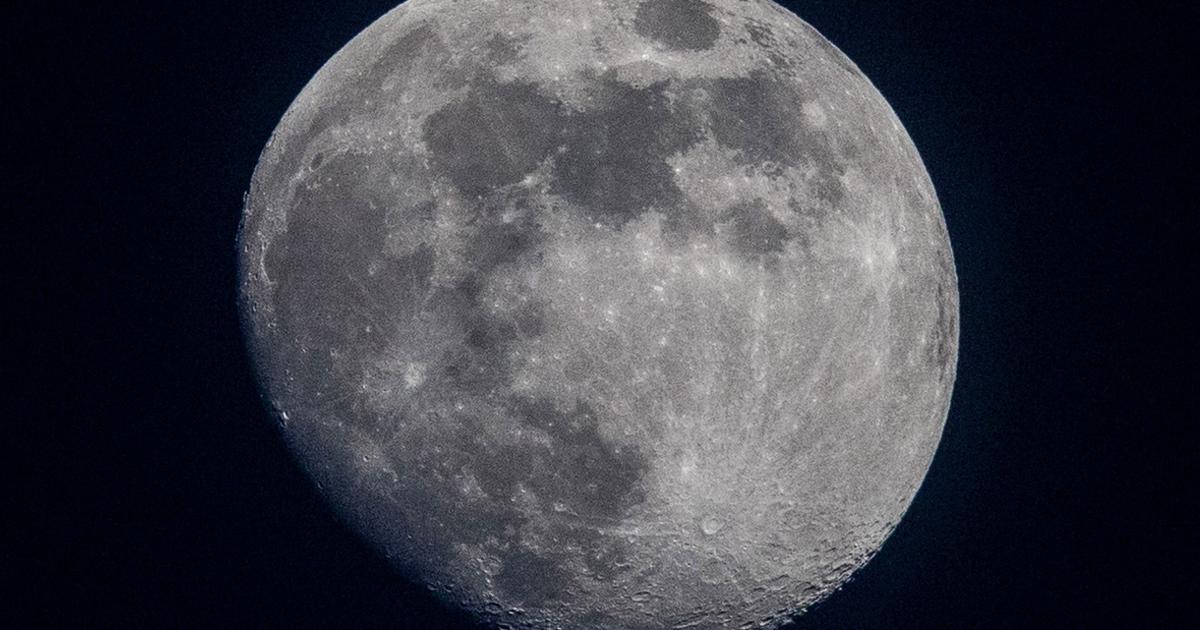The robotic probe Danuri is currently heading toward the Sun to take advantage of the star's enormous gravitational pull and propel itself to its final destination: the Moon.
This is South Korea's first mission there.
The voyage marks the start of a new golden age of exploring the Moon;
six countries will send spacecrafts to that celestial body, which probably formed billions of years ago when a planet the size of Mars collided with the Earth and tore a chunk out of it.
Just like the space race 50 years ago, many of these countries - especially the US, Europe and their Chinese and Russian rivals – seek to demonstrate their technological power, explore the Moon's enormous mineral reserves and turn it into an intermediate station to reach their ultimate target: Mars.
“A new era of space exploration is coming and Korea wants to be part of it,” explains Sungsoo Kim - the Korea Aerospace Research Institute's director of Polcam (one of the four scientific instruments aboard the Danuri) – in an email.
The Asian country's main objective is to develop technology for exploring and communicating with the Moon and other celestial bodies in the solar system.
But the spacecraft will also perform front-line scientific research.
For example, Polcam will be the first camera to study the texture of lunar soil by using polarized light.
“This instrument's purpose is to map the size of lunar regolith particles, which will tell us approximately how long it has been exposed to space conditions,” says Kim.
Two other instruments will analyze the lunar magnetic field's intensity and the abundance of certain strategic elements, such as uranium, helium and water.
A Korean man watches the 'Danuri' probe's launch on television. JEON HEON-KYUN (EFE)
The fourth instrument aboard the Danuri – the NASA-developed ShadowCam – will study “the solar system's most valuable real estate,” as the US agency put it.
That refers to the inside of the large craters of the Moon's south pole, where sunlight does not reach.
These eternally dark cavities are thought to contain tons of ice water, a key resource for providing future astronauts water to drink as well as for making hydrogen-based rocket fuel.
Danuri was launched on August 4, but it will take until December to reach the Moon and begin to orbit around it at an altitude of just 100 kilometers.
In the meantime, other missions from the US and Europe, India, Japan, the United Arab Emirates and China are also expected to attempt to reach the Moon.
Artemis I mission
NASA's Artemis I mission – undoubtedly the most ambitious of all the explorations – is scheduled to launch on August 29. It will be the maiden voyage of both the
Orion
capsule, designed to carry astronauts to the Moon and Mars, and the Space Launch System ( SLS) rocket, the largest and most powerful one ever built.
The European Space Agency (ESA) built the Orion service module, a key component of the rocket.
“This part is like the legs of the spacecraft, providing the propulsion and energy it needs, including solar panels and oxygen, water and nitrogen tanks, while its brain – the electronics and control software – are installed in the capsule itself,” Philippe Deloo , the 61-year-old Belgian engineer who heads Europe's role in the mission, told EL PAÍS.
The SLS rocket and the 'Orion' capsule, at the top.NASA
The service module's thrusters are responsible for carrying the capsule from the Earth's orbit to the Moon, where it will fly just 100 kilometers above the surface.
No humans will be onboard at this time.
Artemis I's only crew members will be three Manikins: one in a full astronaut suit plus two torsos - called Helga and Zohar - to study a special vest's effectiveness against space radiation.
The Orion will make an orbit and a half around the Moon, following an elliptical trajectory.
If all goes well, at its farthest point from the Moon, the capsule will become the farthest human-carrying spacecraft ever to reach space, even farther than the Apollo spacecraft that took man to the Moon over half a century ago.
Cameras aboard the capsule are expected to send spectacular images from the lunar surface and the spacecraft itself back to Earth;
they will be the highest quality pictures of the Earth as seen from the Moon to date.
In 1968, the Apollo astronauts took similarly stunning photos: it was the first time that humans sent a postcard from outer space.
Orion
will take 19 days to complete its route around the Moon.
After that, the European service module will fire its thrusters to bring it back down to Earth in another 19 days.
If everything goes according to plan, the capsule will plunge into the Pacific Ocean on October 10, following a splashdown sequence with 11 parachutes to slow the spacecraft down from 40,000 kilometers per hour to just 30. One key part of the mission is testing the spacecraft's heat shield, which will reach about 3,000 degrees as it re-enters the Earth's atmosphere, Debbie Korth, NASA's Orion Deputy Manager, said at a press conference.
Deloo believes that Artemis is an infinitely more ambitious program than Apollo.
He explains that “[t]his time the intention is to go to the Moon and establish permanent bases,” first orbital bases and then ones on the surface.
“For Apollo, science was a collateral objective.
Now, we're going to deploy all our capabilities to explore the lunar south pole, which is of enormous geological interest and has great potential for commercial mineral extraction.
All of this will teach us whether we can live there independently and use the Moon as a springboard to get to Mars,” he said.
The Earth as seen from the Moon, in a photograph taken by 'Apollo 8' astronaut William Anders. Heritage Images (NASA/Heritage Images via Getty I)
If Artemis I succeeds, in 2024 NASA will launch the first crewed mission to orbit the Moon without landing on it.
The following year, NASA anticipates that a woman will set foot on the Moon for the first time in history.
Her name de ella has not been announced yet, but she will be selected from the current astronaut corps, a group of 42 Americans who are in their late 20s to mid-60s;
almost half of them are women.
Reid Wiseman, NASA's chief astronaut, emphasized inclusivity at a press conference: “As long as you are healthy, we're going to load you on a rocket and shoot you off the planet,” he said.
lunar equality
Much has changed from previous gender-equality programs, including limits on exposure to cancer-causing space radiation.
The guidelines have been completely equalized and no longer vary by gender.
Each candidate for the astronaut corps will be assigned to either Artemis or the International Space Station and undergo different trainings.
Candidates preparing for the Moon will ride in a replica of Orion and spend hours working in the depths of a darkened pool while wearing their lunar exploration suits, among many other tests.
Other countries are planning somewhat more modest missions to the Moon.
Among them, India stands out as a thriving space power;
in 2009, its Chandrayaan-1 probe found water on the Moon, one of the most recent and important lunar discoveries.
In 2019, the country failed in its attempt to land on the moon with its Vikram module.
India plans to make a new attempt in the first four months of 2023.
A NASA astronaut trains underwater.
POT
In 2019, the Chinese landed on the dark side of the Moon for the first time in history.
China is planning several missions to explore the Moon and collect asteroid samples;
it is also building its own space station.
The US and Europe cite China as their main competitor.
Japan is another player in the lunar exploration renaissance.
This year, the Japanese plan to launch the Slim mission, which will attempt the most geographically precise moon landing ever.
The oil-rich United Arab Emirates also hopes to land on the Moon for the first time with Rashid, a small rover;
the Japanese company ispace is participating in that launch as well.
Last year, the UAE successfully launched Al Amal (the Hope), the first Arab spacecraft to orbit another planet, Mars.
Despite being mired in the war in Ukraine, Moscow also wants to participate in the new race to the Moon.
The Soviet Union was the direct rival of the US;
for decades it was the only other nation that could successfully land robotic probes on the Moon.
Things have changed a great deal since then.
Sanctions and the breakdown of cooperation between Moscow and the West on space initiatives makes things much more difficult.
Still, the country maintains its Luna-25 mission, a lander that should have blasted off in July but probably won't launch until 2023, according to the Tass agency.
On Earth, the war in Ukraine has sparked an unprecedented space crisis.
Russia's confusing announcement that it will abandon the International Space Station (ISS; a space base constantly populated by international astronauts 400 kilometers from Earth) in 2024 directly impacts US and European plans to keep the ISS fully operational until 2030. However, all indications point to Russia extending its presence on the ISS beyond the date it announced it would leave, because the country cannot launch its own space station over the next few years.
Deloo, a veteran ESA engineer who oversaw European participation for years, believes that the two Western partners will have little trouble continuing to operate without the Russian module.
“This module's only unique function is de-orbiting the station when it reaches the end of its usefulness.
For the time being, Western members can continue to keep the station in orbit, so there is plenty of time to adapt and operate normally without Russia,” he says.








